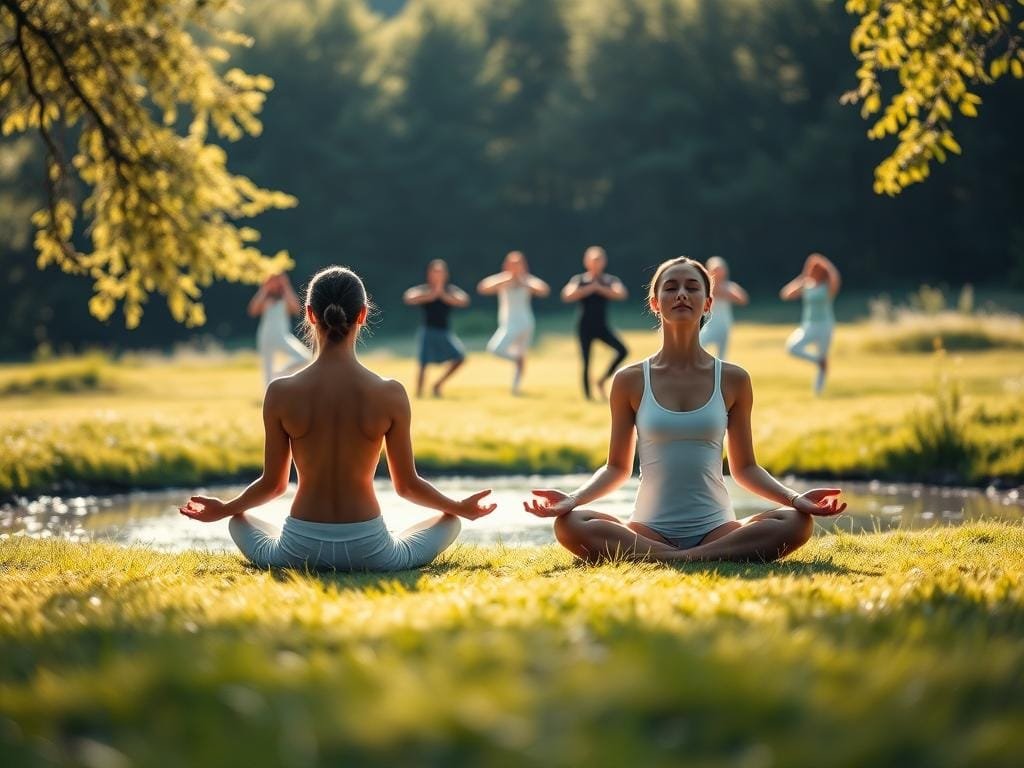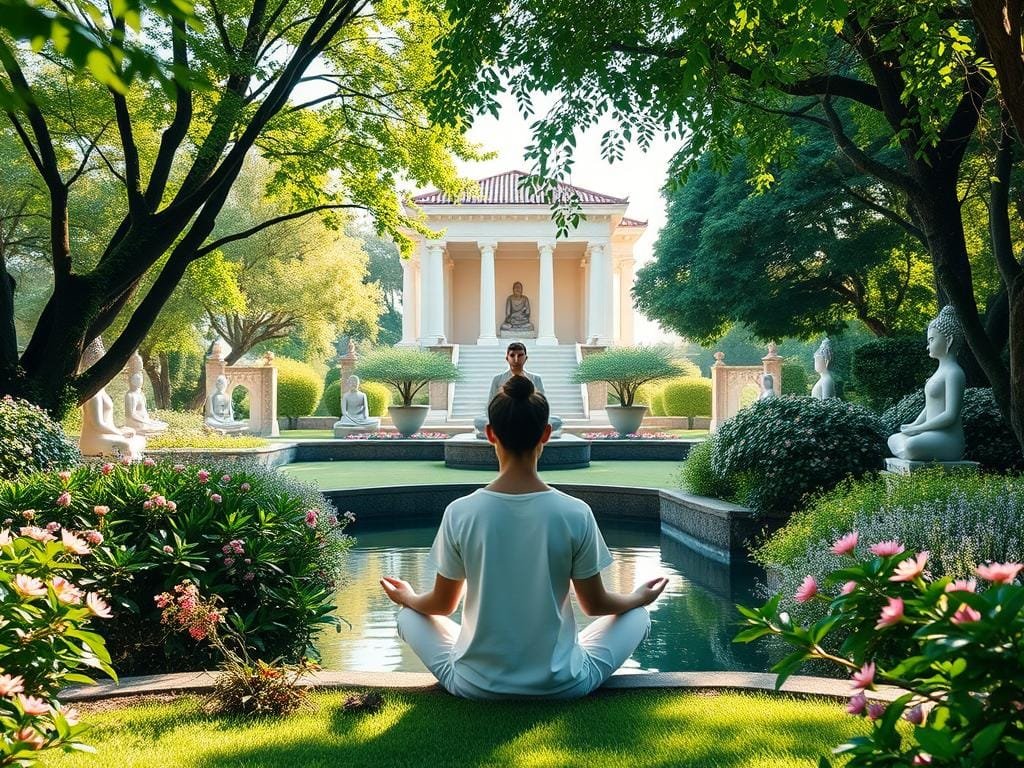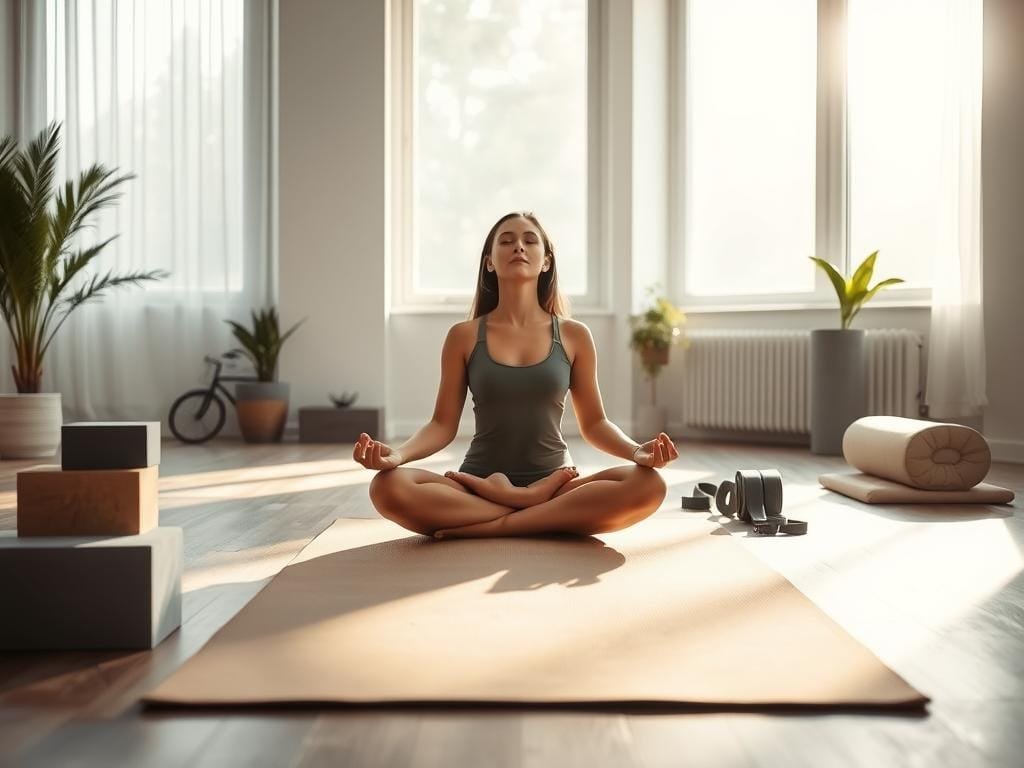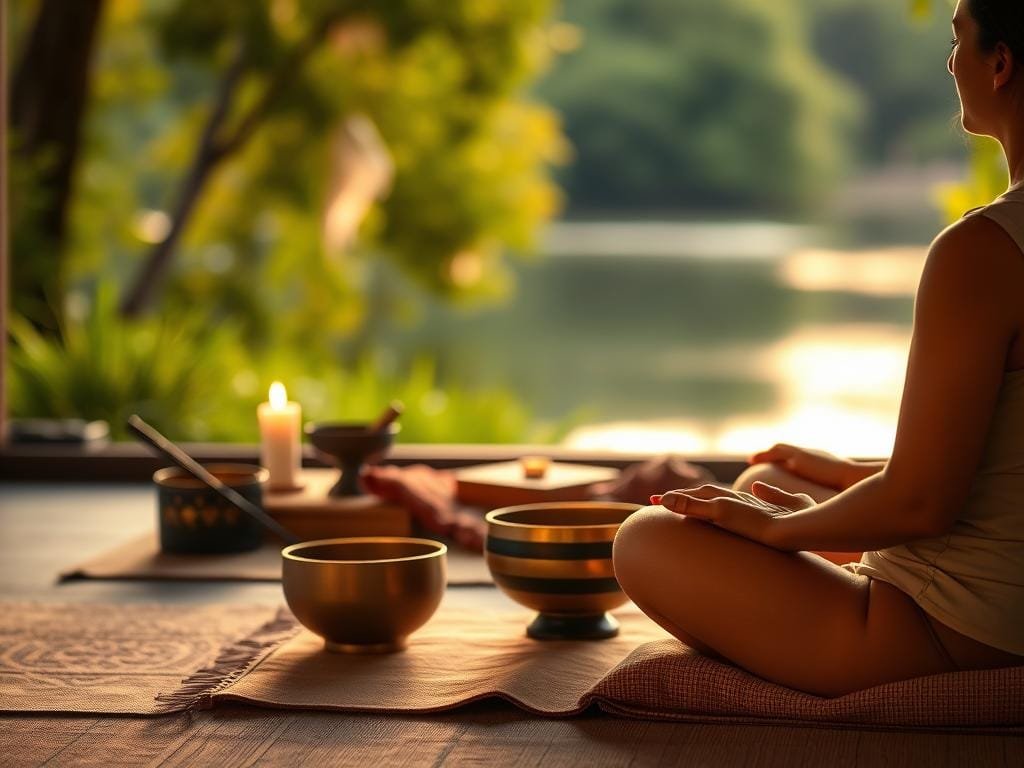Did you know a few minutes of mindfulness each day can change your mental clarity and stress levels? Adding yoga and meditation to your daily routine can greatly improve your wellbeing.
Starting with short mindfulness practices, like 5-minute mindfulness exercises, can lead to a healthier lifestyle. This helps you connect your physical and mental health better.
Table of Contents
Key Takeaways
- Mindfulness practices can reduce stress and anxiety.
- Regular mindfulness practice enhances cognitive functioning.
- Integrating yoga and meditation can lead to holistic fitness.
- Micro-mindfulness sessions can have a compound effect on mental and emotional state.
- Brief mindfulness practices make it easier to build sustainable habits.
Understanding the Basics of Yoga and Meditation
Starting your journey to holistic fitness means learning about yoga and meditation. These practices together help you reach overall wellbeing.
What is Yoga?
Yoga is a mindfulness practice that includes physical postures, breathing, and meditation. It aims to balance body, mind, and spirit. Yoga can make you more flexible, strong, and improve your heart health.
What is Meditation?
Meditation is a way to relax your mind and focus. It helps reduce anxiety and boosts your mood. Just a few minutes of meditation each day can bring you peace.
The Benefits of Practicing Both
Doing yoga and meditation together boosts their benefits. This mix improves your health, mental clarity, and relaxation. Adding both to your daily routine can make life more balanced and fulfilling.
| Practice | Physical Benefits | Mental Benefits |
|---|---|---|
| Yoga | Improved flexibility and strength | Reduced stress and anxiety |
| Meditation | Lower blood pressure | Enhanced mental clarity and focus |
| Yoga and Meditation | Improved overall wellbeing | Greater sense of inner peace and balance |
The Connection Between Yoga and Meditation
Learning about the link between yoga and meditation is vital. They work together to reduce stress and boost well-being. Together, they make your self-care routine even stronger.
How They Complement Each Other
Yoga and meditation are great together. Yoga gets your body ready for meditation by easing tension and boosting flexibility. It also uses breathwork exercises to calm your mind, making meditation easier.
Meditation then deepens the connection between your body and mind. It helps with stress relief and clear thinking.

To learn more about yoga and meditation, check out Meditopia’s blog. It explains how they support each other.
The Science Behind Their Benefits
Studies show yoga and meditation are good for your body and mind. They help lower stress and promote calm. Adding them to your daily life can improve your heart health, flexibility, and mental state.
Regular practice can also make your self-care practices better. This leads to a more balanced and happy life.
By understanding and using the connection between yoga and meditation, you can get the most out of them. This will improve your life quality.
Different Types of Yoga Practices
The world of yoga is full of variety, with many styles to choose from. Each style meets different needs and preferences. You can pick one that fits your goals, whether you want to challenge your body, calm your mind, or grow spiritually.
Hatha Yoga
Hatha Yoga is a traditional yoga that focuses on physical poses and breathing. It aims to balance the body’s energy and prepare it for meditation. This style is slow-paced, making it great for beginners and those who love a calm practice.
Vinyasa Yoga
Vinyasa Yoga, or flow yoga, links breath with movement. It’s a flowing sequence of poses, focusing on the breath. This style is dynamic and challenging, perfect for improving heart health and flexibility.
Ashtanga Yoga
Ashtanga Yoga is fast-paced and physically demanding. It involves a set sequence of poses to build strength, flexibility, and endurance. This style is structured, making it rewarding for those who enjoy a set routine.
Yin Yoga
Yin Yoga is slow and meditative, focusing on the body’s deeper tissues. It involves holding poses for three to five minutes. This style is great for improving flexibility, reducing stress, and making joints more mobile.
| Yoga Style | Focus | Intensity | Benefits |
|---|---|---|---|
| Hatha Yoga | Physical postures and breathing techniques | Low to Moderate | Balances body energy, improves flexibility |
| Vinyasa Yoga | Breath-synchronized movement | Moderate to High | Improves cardiovascular health, flexibility, and strength |
| Ashtanga Yoga | Set sequence of asanas | High | Builds internal heat, strength, flexibility, and endurance |
| Yin Yoga | Holding passive postures | Low | Improves flexibility, reduces stress, enhances joint mobility |
Each yoga practice has its own benefits and can be customized to fit your needs. Knowing what each style offers helps you choose the best one for you. This way, you can enhance your overall wellbeing.
Varieties of Meditation Techniques
Meditation offers many techniques, each with its own benefits. You can find the right one for you by exploring these options. They help with relaxation and mental clarity.
Mindfulness Meditation
Mindfulness meditation focuses on the present moment. You might pay attention to your breath or a mantra. It brings calm and awareness, reducing stress and improving your mind.
Try it by setting aside a few minutes each day. Use apps like Headspace for guided sessions.

Guided Meditation
Guided meditation follows a teacher’s instructions, often through audio. It helps you imagine peaceful scenes or relax your muscles. It’s great for beginners, as it guides you through the practice.
Look for guided meditations online or on mobile apps. Find what suits you best.
Loving-Kindness Meditation
Loving-kindness meditation, or Metta meditation, builds love and kindness. It improves your emotional state and connects you with others. Start by sending kind thoughts to yourself, then to others.
Adding these meditation techniques to your day can greatly benefit your mental health. For more on reducing stress with conscious breathing, visit Boost Healthy Life.
Enhancing Your Yoga Practice with Meditation
Meditation can make your yoga practice better, making it more mindful and fulfilling. It helps you find a balance between body and mind. This makes your fitness journey more complete.
Focusing on Breath
Meditation helps you focus on your breath, which is key in yoga. Breathwork exercises are essential for both practices. They help you move smoothly between poses and stay focused.
Setting Intentions Before Practice
Before starting yoga, setting intentions through meditation is very helpful. It’s about what you want to get from your practice. This could be better flexibility, less stress, or clearer thinking. Setting intentions gives your practice a clear goal.
Using Meditation for Recovery
Meditation is also great for recovery after yoga. It helps your body and mind relax after working out. Guided meditations can help you heal and feel better, reducing muscle tension.
Adding meditation to your yoga routine is a way to take care of yourself. It leads to holistic health. Spending time on both practices brings deep benefits, improving your mental and emotional health.
Creating a Balanced Routine
Creating a routine that includes yoga and meditation can change your life. These practices help you feel better and reduce stress. They are key to a healthy, balanced life.
How to Incorporate Both Practices
To add yoga and meditation to your day, first think about your goals and lifestyle. Figure out how much time you can give to these activities each day. Start with short sessions and grow them as you get more into it.
Try meditating in the morning to clear your mind. Then, do yoga to get your body moving. Or, do yoga in the morning and meditation at night to relax.
Sample Weekly Schedule
Here’s a weekly plan to start:
- Monday: 30-minute morning meditation, 45-minute evening yoga
- Tuesday: 45-minute morning yoga, 20-minute evening meditation
- Wednesday: Rest day or active recovery (e.g., light walking)
- Thursday: 30-minute morning meditation, 45-minute evening yoga
- Friday: 45-minute morning yoga, 20-minute evening meditation
- Saturday: 60-minute yoga or meditation retreat
- Sunday: Rest day or gentle yoga practice

Adjusting to Your Lifestyle
Being flexible is key. Adjust your routine as needed. Listen to your body and change your practice if you need to. If you’re tired, take a rest day or do a gentler practice.
By mixing yoga and meditation into your life, you can live a balanced and healthy way. This approach helps you feel good and manage stress.
Yoga and Meditation for Stress Relief
Modern life can really stress us out. Yoga and meditation are great ways to find peace. They help us deal with the daily hustle and bustle.
These practices have been around for ages. They aim to connect our body, mind, and spirit. You don’t need fancy gear or a lot of time to start feeling better.
How They Reduce Stress
Yoga and meditation calm our minds and bodies. Yoga focuses on breath and movement, taking our minds off stress. Meditation zeroes in on a single point, quieting our thoughts.
Key benefits include:
- Reduced cortisol levels
- Improved mood
- Enhanced sleep quality
- Increased focus and concentration
A study in the Journal of the American Medical Association found that mindfulness meditation can lessen anxiety and depression symptoms.
Mindfulness meditation has been shown to reduce the stress response and increase the relaxation response, leading to a decrease in anxiety and depression.
Techniques to Practice at Home
Starting yoga and meditation at home is easy. Here are some simple steps:
- Try poses like downward-facing dog, child’s pose, and tree pose.
- Do deep breathing exercises, focusing on slow breaths.
- Begin with short meditation sessions, then increase time as you get more comfortable.
Here’s a simple table to help you start a daily routine:
| Day | Yoga Practice | Meditation Duration |
|---|---|---|
| Monday | Hatha Yoga | 10 minutes |
| Tuesday | Vinyasa Yoga | 15 minutes |
| Wednesday | Rest day | 5 minutes |
| Thursday | Yin Yoga | 10 minutes |
Benefits for Physical Health
Yoga and meditation are great for your body. They can make you more flexible and improve your heart health. By doing these activities, you can see big improvements in your physical health.
Improved Flexibility and Strength
Yoga is amazing for getting more flexible and strong. It uses poses and stretches to boost your flexibility and muscle tone. Regular yoga can make everyday tasks easier and lower injury risks.
Heart Health
Yoga and meditation are good for your heart. They can lower blood pressure, improve blood flow, and reduce stress. All these help keep your heart healthy. Hopkins Medicine says yoga can lower heart disease risk.
Pain Management
Yoga and meditation are great for managing pain. They help relax you and lower stress, easing chronic pain. Mindfulness meditation can change how you feel pain, making it easier to handle.
| Physical Health Benefit | Description | Impact |
|---|---|---|
| Improved Flexibility | Increased range of motion through yoga poses | Eases daily activities, reduces injury risk |
| Heart Health | Lower blood pressure, improved circulation | Reduces risk of heart disease |
| Pain Management | Relaxation, stress reduction through meditation | Alleviates chronic pain conditions |
Adding yoga and meditation to your routine can boost your physical health. It also helps with holistic health and mental clarity. For more on health benefits, check out Boost Healthy Life.
Emotional and Mental Health Advantages
Yoga and meditation can deeply impact your emotional and mental wellbeing. They help improve your mental health when practiced together.
Boosting Mood and Resilience
Yoga and meditation boost mood and enhance resilience. They reduce stress and promote relaxation. Regular practice leads to a more positive outlook and better coping with challenges.
Cultivating Mindfulness
Mindfulness is central to yoga and meditation. By cultivating mindfulness, you become more aware of your thoughts and emotions. This helps you manage them better.
Reducing Anxiety and Depression
Research shows yoga and meditation reduce symptoms of anxiety and depression. Adding these practices to your daily routine can lead to better mental health and wellbeing.
Consistency is key to enjoying these benefits. Start with short sessions and increase duration as you get more comfortable.
Incorporating Mindful Movement into Daily Life
Simple mindfulness practices can be easily added to your daily activities. They help you relax and think more clearly. By adding mindful movement to your routine, you can lower stress and feel better overall.
Short Practices for Busy Schedules
Even with a tight schedule, you can find time for mindfulness. Here are a few quick practices to add to your day:
- One-Minute Breathing: Spend one minute focusing on your breath, noticing it go in and out.
- Body Scan: Lie down or sit, and focus on each part of your body, starting with your toes and moving up.
- Mindful Stretching: Do some gentle stretches, paying attention to how your muscles and joints feel.
You can do these practices almost anywhere. Whether you’re at home, at work, or on a break, they’re easy to fit in.
Mindful Walking and Breathing
Mindful walking and breathing are great for daily life. Mindful walking means paying attention to how you walk, feeling your feet touch the ground, and your breath’s rhythm. It’s a way to be mindful while moving.
Mindful breathing can be done anywhere, anytime. It’s about focusing on your breath, noticing its pattern, and letting go of thoughts. This can calm your mind and reduce stress.

Adding these practices to your daily life can make you feel calmer and clearer. Jon Kabat-Zinn, a mindfulness expert, said, “You can’t stop the waves, but you can learn to surf.” This quote shows the heart of mindfulness – learning to face life’s challenges with grace and awareness.
Resources for Learning More
As you explore mindful movement, having the right resources is key. Whether you’re new or experienced, many tools can help your yoga and meditation practice.
Check out these resources to learn more and keep up with your self-care practice. They’ll help deepen your knowledge and keep you consistent.
Books and Apps
Many great books and apps can guide you in yoga and meditation. Apps like Headspace and Calm offer guided sessions. For readers, “The Miracle of Mindfulness” and “Yoga Anatomy” are top picks.
Online Classes and Workshops
Online classes and workshops let you learn from home. Sites like YogaGlo and DoYouYoga have classes for all levels. Experienced instructors help you improve and understand more.
Local Community Centers
Joining a local group can connect you with others and boost your practice. Community centers offer classes and workshops. They provide a supportive community for consistent practice and holistic health.
Using these resources, you can grow your yoga and meditation practice. This will improve your well-being and self-care practices.
Engaging with a Community
As you dive deeper into yoga and meditation, finding others who share your interests can make a big difference. Being part of a community gives you a sense of belonging. It also boosts your mental wellbeing and makes mindfulness practices more rewarding.
Local Groups and Shared Experiences
Looking for local yoga and meditation groups is a smart move. These groups often host classes, workshops, and events. Here, you can practice mindfulness alongside others, which can be incredibly uplifting.
Being part of a community offers many benefits. You’ll get new ideas, stay motivated, and form lasting connections. Whether it’s online or in-person, community involvement can make your practice more fulfilling and balanced.
